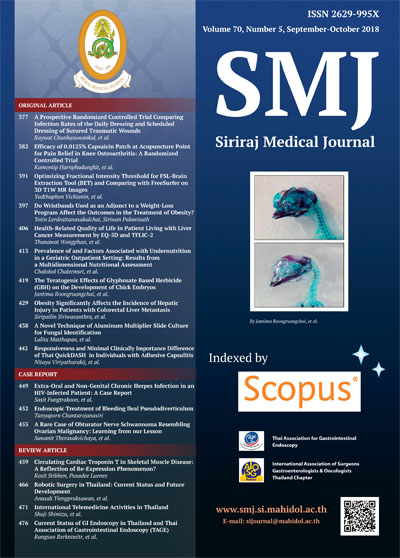Efficacy of 0.0125% Capsaicin Patch at Acupuncture Point for Pain Relief in Knee Osteoarthritis: A Randomized Controlled Trial
Keywords:
Capsaicin patch; acupuncture point; knee osteoarthritisAbstract
Objective: To study the efficacy of 0.0125% capsaicin patch at acupuncture point for pain relief in knee osteoarthritis (OA).
Methods: This randomized, double-blind, placebo-controlled clinical trial was conducted during September 2014
to March 2015. Sixty-two ambulatory patients over 50 years of age with a diagnosis of knee OA were included. All
enrolled patients had a pain score of 4-7 out of 10. Participants were randomized into either the treatment (capsaicin,
n=31) or control (placebo, n=31) group.
Interventions: Capsaicin vs. placebo patch at ST34 (1), SP10 (2), ST35 (3), EX-LE4 (Neixiyan) (4), ST36 (5), and
SP9 (6) acupuncture points for 4 weeks. Main outcome measure: Pain subscale of modified Thai version of Western
Ontario and McMaster (WOMAC) Osteoarthritis Index was assessed at baseline, 2, 4, 6, and 8 weeks after treatment.
Results: Pain subscale of modified Thai version of WOMAC showed no significant difference between groups at
baseline, 2, 4, 6, and 8 weeks after treatment. After 2 weeks of treatment, the pain subscale score in the treatment
group was significantly decreased from baseline (p<0.001). After 4 weeks of treatment, the pain subscale score in
the placebo group was significantly decreased from baseline (p<0.006).
Conclusion: Capsaicin patch at acupuncture point for pain relief in knee OA yielded no significant difference
between groups. However, significant pain relief from baseline was observed in the treatment group after 2 weeks
of treatment and in the placebo group after 4 weeks of treatment. Further study with higher capsaicin concentration
and/or larger size patch should be considered.
Downloads
Published
How to Cite
Issue
Section
License
Authors who publish with this journal agree to the following conditions:
Copyright Transfer
In submitting a manuscript, the authors acknowledge that the work will become the copyrighted property of Siriraj Medical Journal upon publication.
License
Articles are licensed under a Creative Commons Attribution-NonCommercial-NoDerivatives 4.0 International License (CC BY-NC-ND 4.0). This license allows for the sharing of the work for non-commercial purposes with proper attribution to the authors and the journal. However, it does not permit modifications or the creation of derivative works.
Sharing and Access
Authors are encouraged to share their article on their personal or institutional websites and through other non-commercial platforms. Doing so can increase readership and citations.











